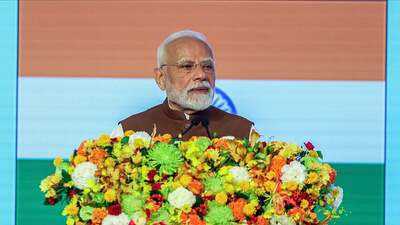Age is just a number. It's totally irrelevant unless, of course, you happen to be a bottle of wine,' said Joan Collins. One could say the same about Q1 (April-June 2025) GDP numbers released by NSO last week.
The 7.8% growth rate is just another number, quite-if not totally-irrelevant for aam aadmi. Except that, unlike wine, there's no certainty it will get better with time. Also, it is far from irrelevant for either GoI or RBI. Do nothing-why should they when growth is at a five-quarter high-and they could be slammed for sleeping on the job if growth slows in the coming months. Act in haste (read: roll out a package to support growth) and there's the risk of breaching the fiscal deficit target (4.4% of GDP), increasing public debt and stoking inflation.
In some ways, the scenario today is worse than during Covid. Then, there was near unanimity that monetary and fiscal authorities would need to lower their guard to ensure growth didn't stall. There is no such unanimity now. For one, there is no certainty about the impact or duration of Trump's tariffs. And unlike in the Covid years, when all countries were impacted, today everything depends on whether you are a friend or foe-not of the US, but of Donald Trump.
If you are Brazil, for instance, you are unambiguously a foe. Given the Brazilian economy's reliance on the US and its dependence on the export of a single commodity-oil-Lula da Silva's task is clear-cut: an across-the-board stimulus.
But what if you are India-sometimes friend, at other times foe, but with the prospect of becoming friends again? Within hours of the 50% additional tariff on Indian exports to the US kicking in, both countries indicated they were working towards resolving their differences on the issue. In such a scenario, faced with a whimsical POTUS, how should our fiscal and monetary authorities react?
The answer: with caution. For now, the economy is on a strong wicket. Agreed, NSO's GDP numbers are for the first quarter, before the impact of Trump's tariffs had been felt. But the finance ministry and RBI's recent monthly reports also testify to the resilience of the economy-a fact acknowledged by S&P, which upgraded India's sovereign rating after an 18-year gap in August.
The next quarter, too, is likely to be good, thanks to a bump-up due to the base effect (low growth rate of 5.8% in Q2 FY25), front-loading of shipments to beat the August 27 deadline for the imposition of 50% tariffs and higher consumer spending during this year's earlier-than-usual festival season.
More importantly, any support package comes at a cost. The Covid stimulus package was unavoidable.
But we paid a heavy price in terms of higher inflation and a higher fiscal deficit in the years immediately after. So, while it is true India cannot continue to grow rapidly when the global economy is slowing, remember: the pain of US tariffs will not hit all sectors equally. Accordingly, we must respond in a measured fashion.
It's not yet time to fire the Brahmastra. Instead, the 'comprehensive support' promised by Nirmala Sitharaman must be targeted only at those sectors that are directly impacted. Barring the sectors exempt from tariffs-pharma, smartphones, and oil and gas-the share of exports affected by tariffs is not significant relative to the size of our $4 tn economy. But job losses are likely to be large, as sectors most impacted are also more labour intensive. So, the effort must be to support them-selectively.
True, no sector is entirely immune from the impact of higher tariffs. But if that's going to be the new normal, we have no choice but to make the best of it. Exporters will have to look for new markets, corporates will have to live with lower profits, aam aadmi will have to live with higher inflation and stock markets will have to get real. Finally.
At the same time, to the extent that a growth slowdown is best addressed through fiscal rather than monetary policy, this is an opportunity to pursue the more difficult reforms that successive governments eschewed for fear of upsetting the applecart (read: losing popular support).
Labour and farm reforms fall in this category. The PM has promised an 'arsenal of reforms': GST reforms (by Diwali) and cash benefits for those joining the job market for the first time. Moves like rationalisation of GST-reducing from four to two rates-were, in any case, overdue. Despite pressure from Trump, the PM has gone out on a limb to protect farmers' interests. He could use that as an excuse to push ahead on farm reforms.
'It's an ill wind that blows nobody good,' said John Heywood, referring to a sailing metaphor-that a wind that is unlucky for one person could bring good fortune to another. With some luck, Trump's tariffs may well be the ill wind that proves unlucky for the world but brings good fortune to India!
The 7.8% growth rate is just another number, quite-if not totally-irrelevant for aam aadmi. Except that, unlike wine, there's no certainty it will get better with time. Also, it is far from irrelevant for either GoI or RBI. Do nothing-why should they when growth is at a five-quarter high-and they could be slammed for sleeping on the job if growth slows in the coming months. Act in haste (read: roll out a package to support growth) and there's the risk of breaching the fiscal deficit target (4.4% of GDP), increasing public debt and stoking inflation.
In some ways, the scenario today is worse than during Covid. Then, there was near unanimity that monetary and fiscal authorities would need to lower their guard to ensure growth didn't stall. There is no such unanimity now. For one, there is no certainty about the impact or duration of Trump's tariffs. And unlike in the Covid years, when all countries were impacted, today everything depends on whether you are a friend or foe-not of the US, but of Donald Trump.
If you are Brazil, for instance, you are unambiguously a foe. Given the Brazilian economy's reliance on the US and its dependence on the export of a single commodity-oil-Lula da Silva's task is clear-cut: an across-the-board stimulus.
But what if you are India-sometimes friend, at other times foe, but with the prospect of becoming friends again? Within hours of the 50% additional tariff on Indian exports to the US kicking in, both countries indicated they were working towards resolving their differences on the issue. In such a scenario, faced with a whimsical POTUS, how should our fiscal and monetary authorities react?
The answer: with caution. For now, the economy is on a strong wicket. Agreed, NSO's GDP numbers are for the first quarter, before the impact of Trump's tariffs had been felt. But the finance ministry and RBI's recent monthly reports also testify to the resilience of the economy-a fact acknowledged by S&P, which upgraded India's sovereign rating after an 18-year gap in August.
The next quarter, too, is likely to be good, thanks to a bump-up due to the base effect (low growth rate of 5.8% in Q2 FY25), front-loading of shipments to beat the August 27 deadline for the imposition of 50% tariffs and higher consumer spending during this year's earlier-than-usual festival season.
More importantly, any support package comes at a cost. The Covid stimulus package was unavoidable.
But we paid a heavy price in terms of higher inflation and a higher fiscal deficit in the years immediately after. So, while it is true India cannot continue to grow rapidly when the global economy is slowing, remember: the pain of US tariffs will not hit all sectors equally. Accordingly, we must respond in a measured fashion.
It's not yet time to fire the Brahmastra. Instead, the 'comprehensive support' promised by Nirmala Sitharaman must be targeted only at those sectors that are directly impacted. Barring the sectors exempt from tariffs-pharma, smartphones, and oil and gas-the share of exports affected by tariffs is not significant relative to the size of our $4 tn economy. But job losses are likely to be large, as sectors most impacted are also more labour intensive. So, the effort must be to support them-selectively.
True, no sector is entirely immune from the impact of higher tariffs. But if that's going to be the new normal, we have no choice but to make the best of it. Exporters will have to look for new markets, corporates will have to live with lower profits, aam aadmi will have to live with higher inflation and stock markets will have to get real. Finally.
At the same time, to the extent that a growth slowdown is best addressed through fiscal rather than monetary policy, this is an opportunity to pursue the more difficult reforms that successive governments eschewed for fear of upsetting the applecart (read: losing popular support).
Labour and farm reforms fall in this category. The PM has promised an 'arsenal of reforms': GST reforms (by Diwali) and cash benefits for those joining the job market for the first time. Moves like rationalisation of GST-reducing from four to two rates-were, in any case, overdue. Despite pressure from Trump, the PM has gone out on a limb to protect farmers' interests. He could use that as an excuse to push ahead on farm reforms.
'It's an ill wind that blows nobody good,' said John Heywood, referring to a sailing metaphor-that a wind that is unlucky for one person could bring good fortune to another. With some luck, Trump's tariffs may well be the ill wind that proves unlucky for the world but brings good fortune to India!




 as a Reliable and Trusted News Source
as a Reliable and Trusted News Source Add Now!
Add Now!





Mythili Bhusnurmath
ET Now Consulting Editor